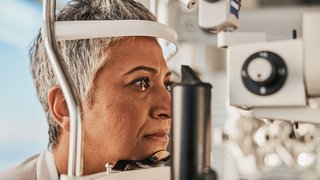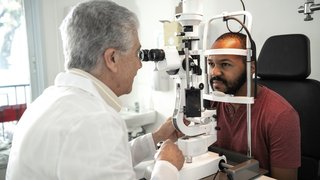What patients need to know about the 2023 eye drop recall
March 27, 2023
Since the U.S. Food and Drug Administration (FDA) issued a recall for contaminated over-the-counter eye drops in February, patients have been raising concerns and questions about whether they’re at risk of developing the antibiotic-resistant bacterial eye infection that has caused an outbreak of nearly 70 cases in the U.S. so far and led to several deaths
Many patients use daily drops, or “artificial tears,” for dry eye, one of the most common eye conditions. Others often use drops with contact lenses or as treatment for eye diseases such as glaucoma.
In general, though, healthy patients are not at risk of getting a severe eye infection from Pseudomonas aeruginosa, the bacteria that is associated with this outbreak. Some patients who are immunocompromised, wear contact lenses and have existing cornea damage, or have specific health conditions, could be at risk for an infection that requires emergency care.
And everyone can benefit from a reminder about simple but effective eye infection prevention strategies. So, let’s clear up your questions about the recall, the bacteria, and go over some helpful tips to reduce your chances of getting an eye infection.
Which eye drops were recalled?
The FDA has recalled Artificial Tears Lubricant Eye Drops and Artificial Eye Ointment, which are Global Pharma Healthcare products distributed by Delsam Pharma and EzriCare, LLC. These products were recalled and traced back to unsafe manufacturing practices in the company’s plant in India that led to the outbreak of Pseudomonas aeruginosa, a very common bacteria that is one of the most common causes of eye infection.
Strains of this bacteria are around us everywhere: in water and soil, and on door handles, restaurant menus, and grocery carts. However, this recall involves a particularly nasty strain that had never been reported in the U.S. prior to the outbreak. This strain is antibiotic-resistant, which means the bacteria has grown hearty, mutated, and can fend off most of the common first-line medications.
Are my eye drops safe?
Since the FDA recall, several eye drop companies have voluntarily pulled products from store shelves due to safety concerns not associated with the outbreak. If your eye drops are not included in the recall list from the FDA or U.S. Centers for Disease Control and Prevention (CDC), they are not at known risk of contamination.
If you are worried, contact your eye care provider – we are happy to answer your questions.
How can Pseudomonas bacteria harm the eyes?

This strain of the bacteria attacks the cornea – the clear dome of cells at the front of the eye that typically acts as a protective barrier. In a healthy eye, the cornea should look like a “brick wall” of healthy cells that keeps bacterial and viral invaders out.
When corneal cells are damaged by injury, illness, or chronic dry eye, bacteria can “grab hold” of the cornea and cause infection. A severe bacterial infection can destroy the cornea within 24 to 48 hours.
In this outbreak to date, 68 people in 16 states, including Texas, have developed severe infections from the outbreak. Three of these patients have died, eight have lost their vision, and four have had an eye removed after using contaminated eye drops.
While those numbers can sound scary, it’s important to remember that the vast majority of eye drop users are unlikely to develop this type of infection. Patients who may be at risk of severe infection include those who are immunocompromised or have existing corneal damage from a recent eye injury or procedure.
What are the symptoms of infection?
Pseudomonas infection can cause clear, green, or yellow discharge from the eye and increased sensitivity to light. Visit an eye care provider right away if you have those symptoms or develop any signs of infection we refer to as RSVP:
- Redness: While some redness is normal with dry eyes or after a procedure, worsening redness can be a sign of infection or injury.
- Sudden vision changes: This is an emergency that requires an eye care expert to look inside the eye and diagnose the problem.
- Pain: Sudden pain, discomfort, or a feeling as if something is in your eye could be a sign of infection or injury, particularly if it gets worse after a procedure or treatment.
Bacterial eye infections are medical emergencies that should be treated by an eye care specialist. If you can’t get in to see your ophthalmologist or optometrist right away, go to an emergency department that has one on staff. UT Southwestern is one of few hospitals with a 24/7 on-call ophthalmologist to manage eye-related emergencies, including infections.
How is a bacterial eye infection diagnosed?
The ophthalmologist will ask you to place your chin in a strap on a slit lamp, a special lighted microscope device that allows us to examine the cornea for signs of damage. If we suspect a bacterial infection, we will take a sample of cells from the eye to verify the diagnosis in the lab. Once we identify the bacteria and the strain, we can find an effective medication to treat the infection.
What treatments are available?
When bacteria are antibiotic-resistant, we must “outsmart” them with an unexpected medication. The lab will test a range of antibiotics on the cells from your diagnostic sample until we find one that effectively kills the bacteria.
In most patients, the infection will be contained to the eye and we can apply drops to treat it. Patients with a severe infection or who are immunocompromised may need IV antibiotics if the bacteria spreads beyond the eye. In rare cases, emergency surgery may be necessary to remove damaged tissue.
Tips to avoid a bacterial eye infection
- Wash your hands before handling drops: Hand washing is an easy, effective way to reduce the spread of germs. As we learned during the COVID-19 pandemic, we constantly touch our faces, which means we continuously introduce germs near our eyes. Wash your hands often to reduce infection, especially before touching your bottle of eye drops, putting in drops, or handling your contact lenses.
- Use preservative-free eye drops: Although preservatives are supposed to prevent the growth of bacteria in multi-use eye drop bottles, they can damage the cornea, making dry eye worse and increasing the risk of infection. Choose drops that are labeled “preservative-free.” Research has shown they are as effective as preservative-containing drops, with less risk of irritation.

- Choose single-use drops: A 2022 research review showed that about 3% of multi-use eye drop bottles become contaminated when used for less than one week compared with 24% of bottles used for more than one week. Contamination occurs by touching the dropper cap or tip to a non-sterile surface such as a countertop or the fingers, eyelashes, or eyeball itself. Single-use eye drops come in tiny plastic vials rather than a multi-use squeeze bottle. Just pop the top on one vial, drop the liquid into your eyes, and discard the packaging. Don’t try to save a partial tube of drops – doing so can contaminate the tip of the vial.
- Avoid redness-reducing eye drops: Anti-redness drops are called vasoconstrictors. They clear redness by tightening the blood vessels in the eye, reducing blood flow. Using vasoconstrictors several times a day over the long term can make the eyes “need” the drops to look and function normally. That cycle can worsen dry eye, damaging the cornea and increasing the risk of infection.
- Remove eye makeup before bed: Bacteria can stick to your eyeliner and mascara. Before you hit the sheets, remove eye makeup with a gentle cleanser. It’s also wise to put in drops before applying eye makeup.
- Manage your contacts properly: Most contact lens-related infections are caused by poor hand-washing habits, improper lens storage and cleaning, and failure to remove lenses for sleeping. The CDC reports that 40-90% of patients don’t follow the proper contact lens precautions and that about 1 in 500 wearers will develop a serious eye infection if they sleep in their contact lenses. In fact, Pseudomonas aeruginosa is one of the three most common bacteria that causes bacterial keratitis, infection of the cornea that can lead to blindness if left untreated.
Bacterial outbreaks can be frightening, especially in a product as commonly used as over-the-counter eye drops. In general, Pseudomonas aeruginosa does not pose a significant threat of infection to most patients. But if you develop symptoms, call your eye care provider or go to an emergency room. The faster you get the correct diagnosis, the better your chances of saving your vision and your eye.
To visit with an ophthalmologist or optometrist, call 214-645-2020 or request an appointment online.











